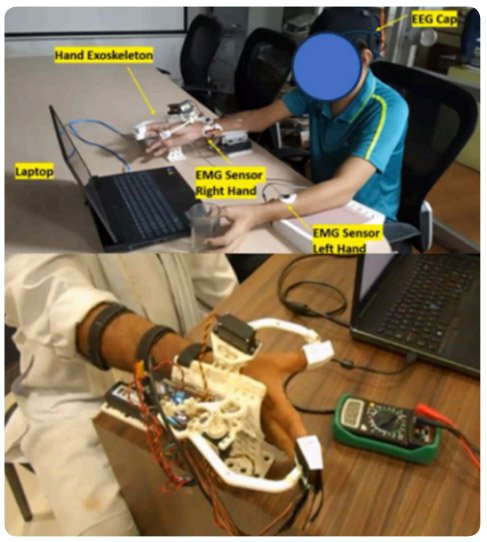Institute:
IIT Kanpuri
PI Name:
Prof. Ashish Dutta
Technology Readiness Level (TRL)
5-6
Stroke is a leading cause of disability worldwide, with
rising cases in India due to increased life expectancy. It
often impairs motor functions, affecting quality of life.
A BCI-controlled robotic hand and arm exoskeleton
can aid post-stroke rehabilitation by combining
mental imagery (Ml) with physical practice (PP). This
integration stimulates brain plasticity and enhances
motor recovery. The BCI detects the patient’s intent
and activates the exoskeleton, reducing the need for
constant physiotherapist supervision and encouraging
functional independence.

| EEG Integration: Yes (non-invasive cap-based EEG) |
|---|
| EMG Sensor Placement: Both hands (for muscle activity monitoring) |
| IMU: For motion tracking and calibration |
| Exoskeleton Type: Hand and arm, modular and robotic |
| System Interface: Laptop-based control with real time feedback |
| Clinical Validation: Completed with approval from Apollo Hospitals |

MZ-122, IIT Delhi, Hauz Khas, New Delhi-110016 India
IHFC, Block – A, Research & Innovation Park, IIT Delhi, Hauz Khas, New Delhi – 110016
07AAFCI6629H1ZE
Designed & Developed by eClerx
© Copyright IHFC 2025 All Rights Reserved.
At Alphoenix Design Pvt. Ltd. We provide custom design and development of high-efficiency BLDC motors for different sectors like EVs, Aviation and Drones, Industrial machinery and Household appliances.
We’ve designed our motors in such a way that its manufacturing process would reduce material waste of motors by 70% and increase efficiency by 5-8%. Our flagship motors provide an efficiency of around 92%-95%. The motor will be manufactured with the capability to utilize CRGO (Cold-Rolled Grain-Oriented) material in its construction.
Our radial flux motors can provide such efficiency with easy manufacturing processes. Utilizing our new motor makes it feasible to achieve an efficiency rating exceeding 95%.
Founded by Marico, Parachute Kalpavriksha Foundation’s objective is to make a difference in the life of Indian farmers. The word “Kalpavriksha” is derived from Devanagari script “Kalpa” (imagination/wish) and “Vriksha” (Tree), meaning the tree that fulfils your wishes. We are a Non-Profit organization working towards the welfare of farmers in India. Currently we have enrolled more than 65,000 farmers covering almost 2.75 Lakh acres of plantation across the states of: Tamil Nadu, Karnataka, Kerala and Andhra Pradesh.
Our team of 100+ Agronomists regularly pay visits to the farmers and educate them on scientific farming practices and help them increase their productivity. Apart from our Productivity improvement program, we provide other services like Agri Expert on phone, Agri Business Centers (ABC), Water conservation activities by construction of farm pond, classroom training to farmers through Kalpavriksha Knowledge Centre etc.